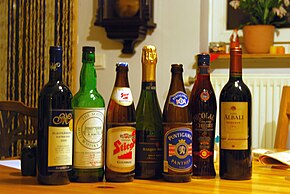**History of Alcoholic Beverages:**
– Discovery of late Stone Age jugs suggests fermented drinks in Neolithic period.
– Oldest brewery found in prehistoric burial site in modern-day Israel.
– Evidence of winemaking in Georgia dated back to 6,000-5,800 BCE.
– Celtic people made alcoholic cider around 3000 BC.
– Distillation spread from the Middle East to Europe in the medieval period.
**Types of Alcoholic Beverages:**
– Beer: Fermented from grain mash, flavored with hops, naturally carbonated.
– Cider: Fermented drink made from fruit juice, alcohol content ranges from 1.2% to 8.5%.
– Mead: Alcoholic drink made by fermenting honey with water, alcohol content ranges from 3% to over 20% ABV.
– Pulque: Mesoamerican fermented drink made from maguey honey water.
– Rice Wine: Alcoholic drink fermented and possibly distilled from rice.
**Production of Alcoholic Beverages:**
– Wine: Most commonly produced from grapes, longer fermentation and aging process compared to beer, alcohol content ranges from 9% to 16% ABV.
– Distilled Beverages: Produced by distilling ethanol from grain, fruit, or vegetables, spirits have at least 20% ABV.
– Rectified Spirit: Alcohol purified by rectification, clear, colorless, flammable liquid with up to 95% ABV.
– Congeners: Substances produced during fermentation, responsible for taste and aroma in alcoholic drinks.
**Alcohol Consumption and Health:**
– Average global alcohol consumption per capita in 2016: 39% of males and 25% of females drink alcohol.
– Alcohol-related crimes include rum-running and transactional sex.
– Short-term and long-term effects of alcohol consumption on health.
– Relationship between alcohol consumption and mortality: Excessive consumption leads to higher mortality, while moderate drinkers have the lowest risk.
**Regulations and Impact of Alcohol:**
– Alcohol laws regulate manufacturing, distribution, sale, and consumption.
– Legal drinking age varies between countries, laws include restrictions on sales hours and days.
– Alcohol is a high-risk carcinogen according to the WHO, contributes to global burden of disease and mortality.
– Global impact and statistics on alcohol consumption, efforts to educate consumers about health risks through warning labels and interventions.
An alcoholic beverage (also called an adult beverage, alcoholic drink, strong drink, or simply a drink) is a drink that contains ethanol, a type of alcohol and is produced by fermentation of grains, fruits, or other sources of sugar. The consumption of alcoholic drinks, often referred to as "drinking", plays an important social role in many cultures. Alcoholic drinks are typically divided into three classes—beers, wines, and spirits—and typically their alcohol content is between 3% and 50%.


Most countries have laws regulating the production, sale, and consumption of alcoholic beverages, and the temperance movement advocates against the consumption of alcoholic beverages. Regulations may require the labeling of the percentage alcohol content (as ABV or proof) and the use of a warning label. Some countries ban the consumption of alcoholic drinks, but they are legal in most parts of the world. The global alcoholic drink industry exceeded $1.5 trillion in 2017.

Alcohol is one of the most widely used recreational drugs in the world, and about 33% of all humans currently drink alcohol. In 2015, among Americans, 86% of adults had consumed alcohol at some point, with 70% drinking it in the last year and 56% in the last month. Several other animals are affected by alcohol similarly to humans and, once they consume it, will consume it again if given the opportunity, though humans are the only species known to produce alcoholic drinks intentionally.
Alcohol is a depressant, which in low doses causes euphoria, reduces anxiety, and increases sociability. In higher doses, it causes drunkenness, stupor, unconsciousness, or death. Long-term use can lead to an alcohol use disorder, an increased risk of developing several types of cancer, cardiovascular disease, and physical dependence. According to the World Health Organization, alcohol is in the highest risk-group carcinogen, and no quantity of its consumption can be considered safe.
